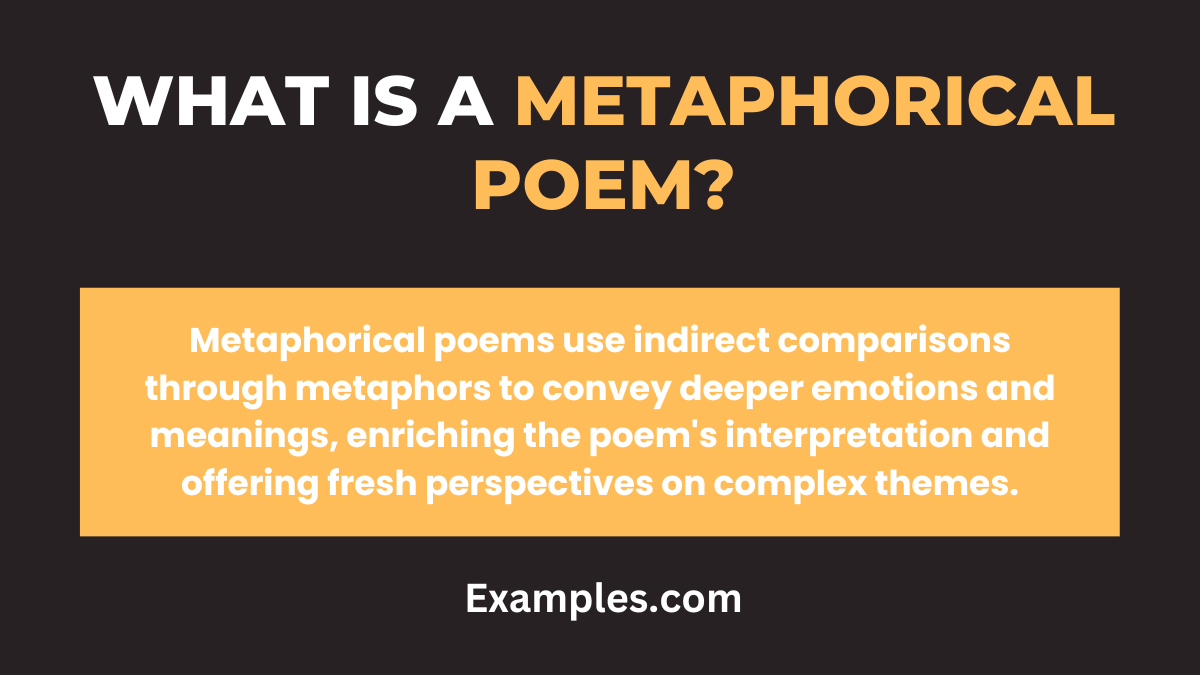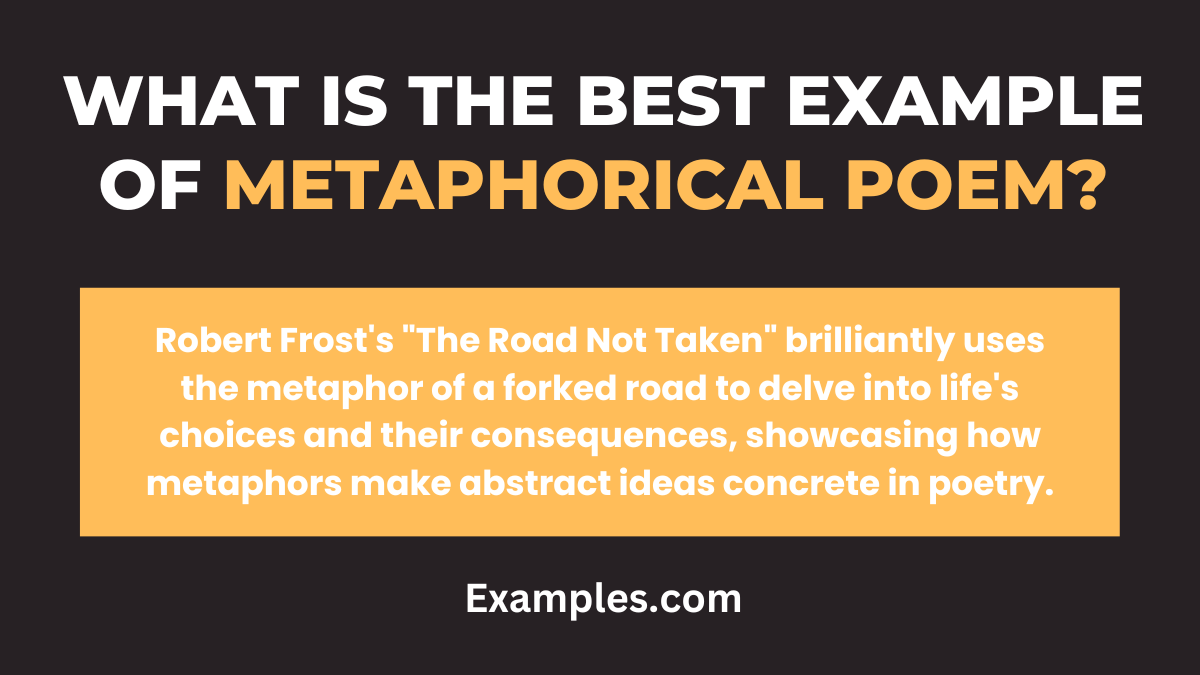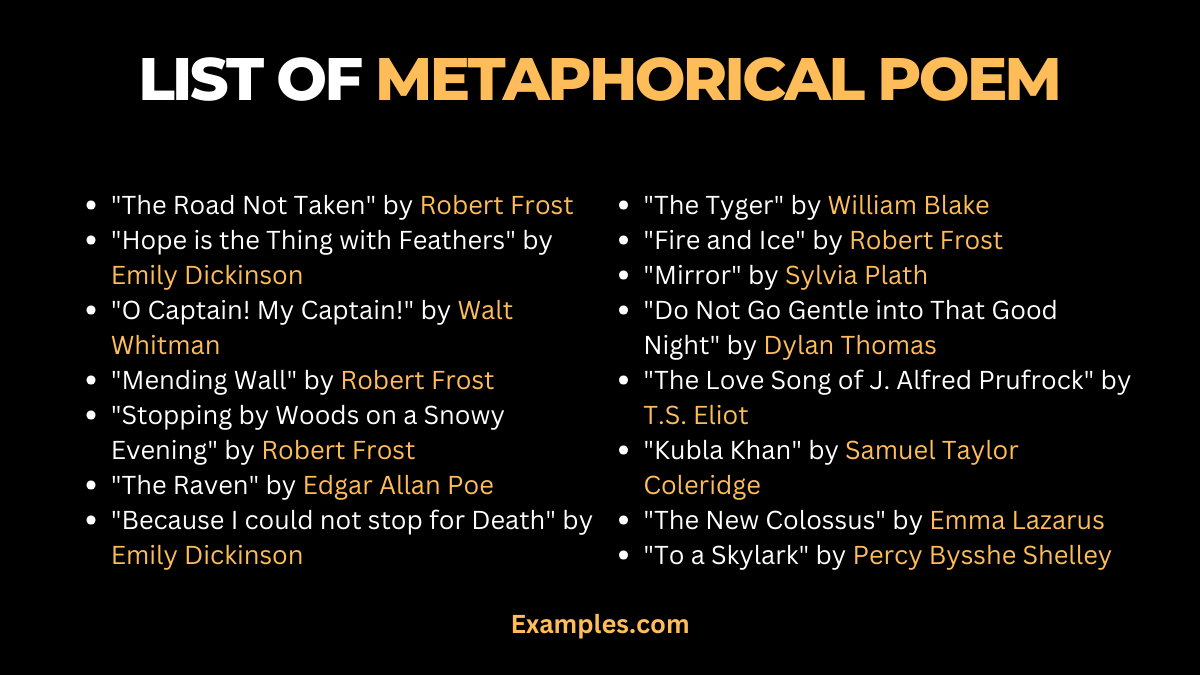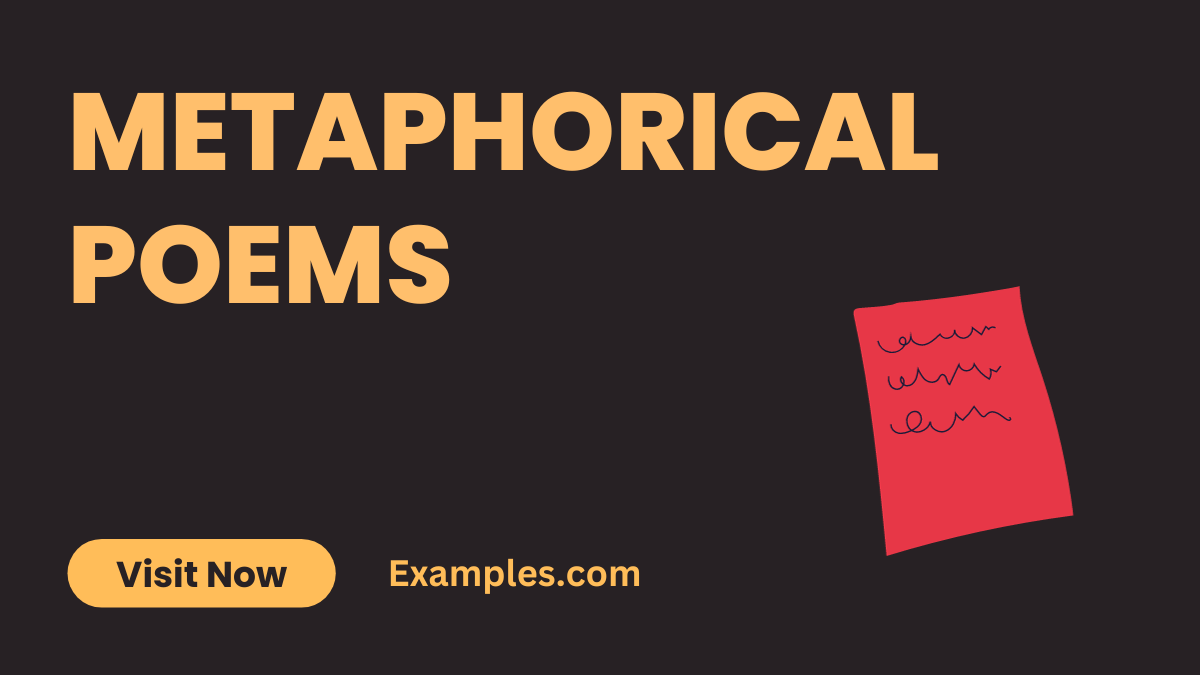14+ Metaphorical Poems Examples
Delve into the enchanting world of Metaphorical Poems, where words transcend their literal sense to paint vivid images and evoke deep emotions. This comprehensive guide explores the art of using Metaphor Examples to create impactful poetry. From the subtle nuances of everyday life to the profound depths of human experience, these examples illustrate how metaphorical poems capture the essence of feelings and thoughts, making them relatable and profound. Embark on a journey to discover the beauty and power of metaphorical poetry.
What is a Metaphorical Poem?

A Metaphorical Poem is a form of poetry that uses metaphors to convey deeper meanings and emotions. Unlike literal language, metaphors create indirect comparisons, adding layers of interpretation and richness to the poem. These poems often explore complex ideas or feelings by drawing parallels with more tangible or familiar images, allowing readers to explore new perspectives and insights. Metaphorical poems are a powerful tool in literature, offering a unique way to express and connect with diverse themes.
What is the best Example of Metaphorical Poem?

One of the best examples of a metaphorical poem is Robert Frost’s “The Road Not Taken.” This poem uses the metaphor of a fork in a road to explore the theme of choices and their impact on life. The road symbolizes life’s journey and the choices we face, while the path taken (and the one not taken) reflects the decisions that shape our lives. This poem beautifully illustrates how metaphors can add depth and meaning to poetry, making abstract concepts tangible and relatable.
List of Metaphorical Poem
Download Metaphorical Poem PDF

1. “The Road Not Taken” by Robert Frost
The Road Not Taken Written in 1916, this poem is a classic metaphor for life’s choices, often mistaken as a celebration of individualism but more subtly reflecting on the nature of choice and its consequences. Its enduring appeal lies in its universal theme of decision-making. It’s frequently referenced in discussions about life’s critical decisions.
Metaphors:
- “Two roads diverged in a yellow wood” – Opening Line: Symbolizes life’s choices and diverging paths.
- “And sorry I could not travel both” – Line 2: Reflects the inevitability of making decisions and the impossibility of experiencing every path.
- “I took the one less traveled by” – Closing Stanzas: Represents the choice of a unique or unconventional path in life.
2. “Hope is the Thing with Feathers” by Emily Dickinson
Composed around 1861, this poem personifies hope as a bird, demonstrating Dickinson’s mastery of abstract concept depiction. It’s a powerful piece about resilience and inner strength, often cited in contexts of enduring hardship and maintaining optimism.
Metaphors:
- “Hope is the thing with feathers” – Opening Line: Compares hope to a bird, suggesting its lightness and ability to uplift.
- “That perches in the soul” – Line 2: Indicates hope’s deep-seated presence within the human spirit.
- “And sings the tune without the words” – Line 3: Describes hope as an indescribable, constant force in our lives.
3. “O Captain! My Captain!” by Walt Whitman
O Captain! My Captain! by Whitman’s 1865 elegy to Abraham Lincoln employs maritime imagery to convey themes of leadership, loss, and national tragedy. Widely used in educational settings, it’s a poignant metaphorical reflection on Lincoln’s role during the Civil War and his assassination.
Metaphors:
- “O Captain! My Captain!” – Refrain: Portrays Lincoln as the captain, symbolizing his leadership.
- “Our fearful trip is done” – Line 1: Represents the end of the Civil War.
- “The ship has weather’d every rack” – Line 2: Symbolizes the United States enduring the hardships of war.
4. “Mending Wall” by Robert Frost
Published in 1914, Frost’s poem explores the metaphor of wall-building to delve into themes of boundaries in human relationships and society. It’s often interpreted as a commentary on the paradoxes of isolation and community. The poem is widely studied in literature courses for its rich symbolic content.
Metaphors:
- “Something there is that doesn’t love a wall” – Opening Line: Suggests a natural resistance to barriers and divisions.
- “Good fences make good neighbors” – Frequently Quoted Line: Implies that boundaries, whether physical or metaphorical, can be beneficial.
- “Before I built a wall I’d ask to know / What I was walling in or walling out” – Lines 32-33: Questions the purpose and necessity of divisions in human relationships.
5. “Stopping by Woods on a Snowy Evening” by Robert Frost
Written in 1922, this poem is a serene yet profound meditation on the allure of peace and the inevitability of responsibilities. It’s frequently cited in discussions of life’s temptations and duties. The juxtaposition of natural beauty and personal obligation offers a universal reflection on human experience.
Metaphors:
- “Whose woods these are I think I know” – Line 1: Symbolizes life’s mysteries and unexplored paths.
- “The woods are lovely, dark and deep” – Line 13: Represents the allure and potential danger of escaping life’s responsibilities.
- “But I have promises to keep” – Line 14: Implies the obligations and duties that call us back to reality.
Famous Metaphorical Poems
1. “Hope is the Thing with Feathers” by Emily Dickinson
Emily Dickinson’s poem, written around 1861, uses the metaphor of a bird to describe hope. It portrays hope as a persistent and comforting presence within the human soul. The poem’s beauty lies in its simplicity and the depth of its metaphor, which has resonated with readers for generations.
Metaphors:
- “Hope is the thing with feathers” – Opening Line: Compares hope to a bird, suggesting it is uplifting and free.
- “That perches in the soul” – Line 2: Implies that hope resides deeply within the human spirit.
- “And sings the tune without the words” – Line 3: Describes hope as a wordless, continuous song in our hearts, always present even without specific articulation.
2. “O Captain! My Captain!” by Walt Whitman
Written in 1865, Whitman’s poem is a metaphorical elegy for Abraham Lincoln. The poem uses the extended metaphor of a ship and its captain to represent the United States and Lincoln, respectively. It is famous for its emotional depth and poignant portrayal of the nation’s grief at Lincoln’s assassination.
Metaphors:
- “O Captain! My Captain!” – Refrain: Represents Abraham Lincoln as the captain of the ship, symbolizing the United States.
- “Our fearful trip is done” – Line 1: Signifies the end of the Civil War.
- “The ship has weather’d every rack, the prize we sought is won” – Line 2: Suggests that the nation has survived the turmoil of war and achieved its goal of unity.
Funny Metaphorical Poems
1. “The Dancing Moonlight Jamboree”:
Originating from the whimsical tales of folklore, “The Dancing Moonlight Jamboree” is a humorous metaphorical poem that captures the playful antics of nocturnal creatures under the moon’s glow. Often recited at children’s bedtime or in playful adult gatherings, it uses vivid imagery to paint a scene of animals having a secret party at night, bringing to life the mysteries of the moonlit world with a touch of humor and fantasy.
Metaphors:
- “Moon’s Cheesy Grin” – Opening Line: Refers to the full moon smiling down on the earth, setting the stage for the night’s festivities.
- “Owls in Tuxedos” – Mid Poem: Illustrates owls looking formal and sophisticated, humorously personifying them as distinguished party guests.
2. “The Great Vegetable Uprising”:
“The Great Vegetable Uprising” is a light-hearted, metaphorical poem about vegetables gaining consciousness and revolting against being eaten. It’s a favorite in school literature programs and vegetarian communities, humorously promoting the idea of vegetables having their own personalities. The poem whimsically personifies various vegetables, turning a mundane kitchen scene into a comedic battleground where carrots and peas plot their escapade.
Metaphors:
- “Carrots Brandishing Swords” – Third Stanza: Implies carrots taking a stand and fighting back, symbolizing resistance in a humorous way.
- “Potatoes Rolling in Protest” – Fifth Stanza: Represents potatoes actively resisting their fate, adding a comical twist to the idea of non-violent protest.
3. “The Clock’s Lazy Afternoon”:
Set in the backdrop of a sleepy afternoon, “The Clock’s Lazy Afternoon” is a metaphorical poem that personifies time as a lazy character, dawdling through the day. Popular in leisurely settings like cafes or lazy Sunday readings, the poem amusingly contrasts the relentless march of time with a languid, carefree attitude. It’s a humorous take on the concept of time, often used to lighten the mood or bring a smile during a slow day.
Metaphors:
- “The Hour Hand’s Leisurely Stroll” – First Stanza: Portrays the hour hand of a clock moving slowly, akin to a relaxed walk, highlighting the slowness of time.
- “Minutes Muttering in a Nap” – Middle of the Poem: Depicts minutes as sleepy murmurs, giving a sense of time dozing off in the afternoon.
3. “Mending Wall” by Robert Frost
Published in 1914, Robert Frost’s “Mending Wall” is a narrative poem that explores the boundaries in human relationships through the literal act of rebuilding a wall. The poem, rich in metaphorical significance, is often used to discuss themes of isolation, cooperation, and the human tendency to build figurative walls.
Metaphors:
- “Something there is that doesn’t love a wall” – Opening Line: Nature’s aversion to barriers, symbolizing the natural resistance to human-made separations.
- “Good fences make good neighbors” – Line 27: The paradox of barriers fostering healthy relationships.
- “Bringing a stone grasped firmly by the top” – Throughout the Poem: The deliberate act of building barriers, both physical and metaphorical.
4. “Stopping by Woods on a Snowy Evening” by Robert Frost
Robert Frost’s 1922 poem, “Stopping by Woods on a Snowy Evening,” uses the simple scene of a traveler pausing to watch snow falling in the woods as a metaphor for life and its obligations. This poem is widely regarded as an exploration of the tension between the desire for peace and the relentless demands of life’s responsibilities.
Metaphors:
- “Whose woods these are I think I know” – Line 1: Symbolizes life’s mysteries and unknowns.
- “He will not see me stopping here” – Line 3: The isolation and autonomy in personal choices.
- “But I have promises to keep” – Line 14: Obligations and duties that drive life’s actions.
5. “The Raven” by Edgar Allan Poe
Edgar Allan Poe’s “The Raven,” written in 1845, is a narrative poem known for its atmospheric exploration of themes like grief and despair. The poem, through its use of a raven as a central metaphor, delves into the human psyche’s darker aspects. It’s often cited in discussions about loss, mourning, and the supernatural.
Metaphors:
- “The Raven” – Throughout the Poem: Represents unending grief and the haunting nature of lost love.
- “Darkness there and nothing more” – Line 24: The unknown, often associated with fear and despair.
- “And my soul from out that shadow” – Line 108: The struggle of the self to emerge from the depths of sorrow and darkness.
Short Metaphorical Poems
1. “The Road Not Taken” by Robert Frost
This iconic poem by Robert Frost is a metaphor for life’s choices and the paths we take. Written in 1916, it has become a staple in American literature, often used to symbolize the importance of making decisions and the impact they have on our lives. The poem’s narrative reflects a traveler’s decision at a fork in the road, symbolizing life’s crossroads where we must choose our direction.
Metaphors:
- “Two roads diverged in a yellow wood” – Opening Line: This metaphor represents life’s choices. The roads symbolize different paths or decisions we face.
- “And sorry I could not travel both” – Line 2: It expresses the impossibility of experiencing every opportunity in life, highlighting the exclusivity of choices.
2. “Hope is the Thing with Feathers” by Emily Dickinson
Emily Dickinson’s short poem, written around 1861, uses metaphor to describe hope as a bird. This poem is celebrated for its simplicity and profound depth, encapsulating the enduring and uplifting nature of hope. It is often cited in times of hardship or to inspire resilience, emphasizing hope’s pervasive and unyielding presence in the human spirit, even in the darkest times.
Metaphors:
- “Hope is the thing with feathers” – Opening Line: Hope is likened to a bird, suggesting its ability to uplift and soar above life’s challenges.
- “That perches in the soul” – Line 2: This metaphor indicates that hope resides deep within the human spirit, providing inner strength.
3. “Ozymandias” by Percy Bysshe Shelley
Written in 1818, “Ozymandias” is a sonnet by Shelley that explores the inevitable decline of all leaders and empires through the metaphor of a ruined statue. The poem serves as a powerful reminder of the impermanence of power and the hubris of those who wield it. It’s often referenced in discussions about the fleeting nature of political power and the ravages of time on human achievements.
Metaphors:
- “Two vast and trunkless legs of stone” – Line 2: Represents the remains of great works, symbolizing the inevitable decay of power and legacy.
- “The sneer of cold command” – Line 5: This metaphorical description of the statue’s face reflects the arrogance and authoritarian nature of power.
4. “The Fog” by Carl Sandburg
Carl Sandburg’s short poem, penned in 1916, personifies fog as a cat, using this metaphor to describe the fog’s silent, graceful, and mysterious arrival into the city. The poem is revered for its simplicity and vivid imagery, often used to illustrate the beauty of nature and its subtle yet impactful presence. It captures the essence of fog’s ephemeral nature and its gentle envelopment of the landscape.
Metaphors:
- “The fog comes on little cat feet” – Opening Line: This metaphor compares the quiet, stealthy approach of fog to a cat’s gentle footsteps.
- “It sits looking over harbor and city” – Line 3: Likening the fog to a contemplative animal, this metaphor emphasizes its calm and observant nature.
Metaphorical Poems for Student
1. “Hope is the Thing with Feathers” by Emily Dickinson
Written by Emily Dickinson around 1861, this poem personifies hope as a bird that sings endlessly. It’s often used to teach metaphorical and abstract thinking in literature classes. The poem beautifully encapsulates the endurance and comforting presence of hope in human life.
Metaphors:
- “Hope is the thing with feathers” – Opening Line: Hope is metaphorically described as a bird, suggesting its ability to uplift.
- “That perches in the soul” – Line 2: This indicates that hope resides deep within the human spirit.
2. “O Captain! My Captain!” by Walt Whitman
Walt Whitman wrote this poem in 1865 as a metaphorical tribute to Abraham Lincoln following his assassination. The poem is a classic example of extended metaphor, widely taught in schools for its historical context and rich metaphorical language. It symbolizes the loss of a leader and the end of a turbulent period in American history.
Metaphors:
- “O Captain! My Captain!” – Refrain: Represents Abraham Lincoln, metaphorically depicted as the captain of the ship, i.e., the United States.
- “The ship has weather’d every rack” – Line 2: Symbolizes the United States surviving the Civil War under Lincoln’s leadership.
3. “The Raven” by Edgar Allan Poe
Edgar Allan Poe’s “The Raven,” published in 1845, is a narrative poem known for its dark, atmospheric depiction of mourning and loss. The poem is a favorite in literature classes for its rich use of symbolism and metaphor. It explores themes of grief, the afterlife, and the subconscious mind.
Metaphors:
- “Midnight dreary” – Opening Line: Represents a time of darkness and uncertainty, both literally and metaphorically.
- “The Raven” – Throughout the Poem: Acts as a metaphor for death, doom, or a messenger from the afterlife.
Metaphorical Poems About Life
1. “Still I Rise” by Maya Angelou
Maya Angelou’s “Still I Rise” is a powerful poem about overcoming adversity and discrimination. Written during a time of rampant racial inequality, this poem serves as a defiant response to the oppression Angelou and others faced. Its vivid metaphors and resilient tone make it a seminal work in American literature, resonating with anyone who has faced and overcome hardship.
Metaphors:
- “You may trod me in the very dirt, But still, like dust, I’ll rise” – Second stanza: This metaphor compares the speaker’s resilience to dust rising from the ground, symbolizing an unbreakable spirit.
- “Just like moons and like suns, With the certainty of tides” – Third stanza: Here, Angelou uses celestial bodies as metaphors for inevitable, consistent resilience and renewal.
2. “Ode to the West Wind” by Percy Bysshe Shelley
“Ode to the West Wind” is a classic poem by Percy Bysshe Shelley that uses the West Wind as a metaphor for change and renewal. Written in 1819, it reflects Shelley’s revolutionary ideals and his desire for transformation in society and personal life. The poem’s rich metaphors are often analyzed for their portrayal of nature’s power and its parallel to human experiences.
Metaphors:
- “Destroyer and preserver” – First stanza: The West Wind is metaphorically described as both a force of destruction and preservation, symbolizing change and renewal.
- “The trumpet of a prophecy” – Fourth stanza: This metaphor suggests that the wind heralds significant change, much like a trumpet announces important news.
3.”The Love Song of J. Alfred Prufrock” by T.S. Eliot
T.S. Eliot’s “The Love Song of J. Alfred Prufrock” is a modernist poem that explores the inner psyche of the protagonist, Prufrock. The poem, filled with vivid and at times fragmented metaphors, delves into themes of indecision, unfulfilled desires, and existential angst. Its metaphors are often dissected for their complex representation of modern life’s disquiet and alienation.
Metaphors:
- “Let us go then, you and I, When the evening is spread out against the sky” – Opening lines: This metaphor sets the scene for a journey, comparing the evening sky to a canvas, symbolizing life’s vast possibilities.
- “In the room the women come and go Talking of Michelangelo” – Second stanza: This represents the superficial social interactions and Prufrock’s alienation from them.
Metaphorical Poems About love
1. “Sonnet 18” by William Shakespeare
“Sonnet 18,” also known as “Shall I compare thee to a summer’s day?” is one of Shakespeare’s most famous sonnets, celebrating the beauty of the beloved. Written in the early 17th century, it compares the beloved’s beauty to the timeless and transcendent aspects of nature. The poem is often used to express eternal love and has been a staple in literature classes worldwide for its rich metaphorical language.
Metaphors:
- “Shall I compare thee to a summer’s day?” – Line 1: Shakespeare compares the beloved to a summer’s day, suggesting their beauty is more lovely and temperate.
- “And summer’s lease hath all too short a date” – Line 4: Here, summer’s time is compared to a lease, highlighting the transient nature of beauty and life.
2. “A Red, Red Rose” by Robert Burns
“A Red, Red Rose” by Robert Burns, written in 1794, is a song in Scots that expresses deep, enduring love using natural metaphors. The poem’s origin is in Scottish folk tradition, and it has been widely used in literature and music. It’s known for its simplicity and evocative imagery, often used in romantic contexts to symbolize undying affection.
Metaphors:
- “O my Luve is like a red, red rose” – Line 1: The beloved is compared to a red rose, symbolizing deep passion and beauty.
- “O my Luve is like the melody” – Line 2: The beloved’s charm is likened to a sweet melody, suggesting their presence is as enchanting as music.
In conclusion, these metaphorical poems by celebrated poets like Robert Frost, Emily Dickinson, and Walt Whitman offer profound insights into the human experience. Their skillful use of metaphors transforms ordinary scenarios into deep reflections on life, hope, leadership, relationships, and responsibilities. These timeless pieces continue to resonate, encouraging readers to explore the layers of meaning within their own lives and the world around them.



